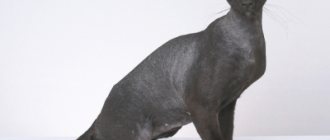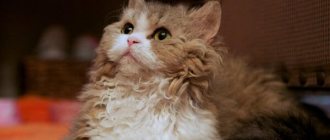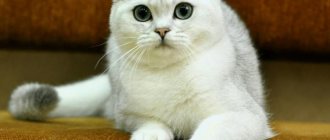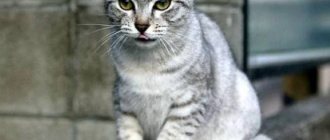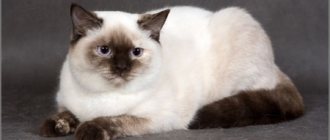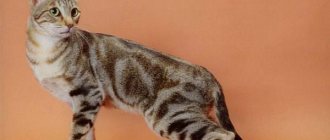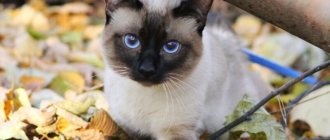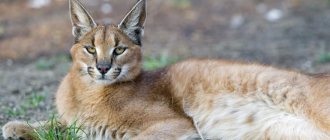Habitat
Felids are found in all terrestrial habitats, with the exception of treeless tundra and polar ice regions. Most species have unique habitats and can be found in a wide range of different environmental conditions. However, only a few of them are adapted to limited habitats. For example, optimal habitat conditions for sand cats (Felis margarita) include sandy and rocky deserts. Domestic and stray cats (F. catus) are found throughout the world and are especially common in urban and suburban areas.
Description
All cats bear a strong resemblance to each other. Unlike members of the canid family (Canidae), felines have short mouths and a characteristic dental formula, which increases their bite force. The loss or reduction of premolars and molars is especially evident in felines, which have a typical dental formula of 3/3, 1/1, 3/2, 1/1 = 30. In most species, the upper premolar is significantly reduced, and in lynxes (Lynx), completely absent. Felines have well-developed carnassial teeth. Their cheek teeth are tuberculate and specialized for cutting meat. The fangs are typically long and tapered, and are ideal for piercing the tissues of prey with minimal force. Cats also have a vestigial baculum and retractable claws. Most cats have five toes on their front paws and four on their back paws.
Body weight varies from 2 kg in black-footed cats (Felis negripes) to 300 kg in tigers (Panthera tigris), and there is sexual dimorphism, with males being larger and more powerful than females. In some species, such as lions (Panthera leo), males may also have ornamentation that is used to attract potential mates. Throughout the range, cats' coats are longer where environmental temperatures tend to be low (such as snow leopards). Felids display a wide range of coat colors from black to white, and many species possess cryptically colored coats containing rosettes, spots and stripes that help camouflage the animals when hunting. Melanistic variants (solid black) are common in many species, but all-white individuals tend to be rare. Large changes in coat color can occur within individual species and ages. For example, adult pumas (Puma concolor) rarely have spots, while their kittens almost always have them. In general, cats' bellies are usually light in color, and the face, tail, and back of the ears often have black or white markings.
Felids have a number of morphological adaptations that have allowed them to become the most skilled hunters among carnivores. They are digitigrade, which allows them to move quickly. Their powerful limbs help them capture and hold large prey. Often, cats have a mysterious camouflage that makes them invisible while hunting. Additionally, many felines have large eyes and exceptional vision. In nocturnal species, the tapetum helps capture limited light. Most species are famous for their large, slightly structured, rotating ears. And finally, their tongue has a sandy-texture, which helps keep food in their mouths and separate meat from the bones of prey.
Third place – Jaguar (Panthera onca)
Jaguar
The Jaguar is the largest cat in the Americas and the third largest in the world. The preferred habitats of jaguars are swamps and wooded areas; but they also live in bushes and deserts. The largest population of jaguar is in the Amazon rainforest. Jaguars roar, they have a powerful jaw, sharp and strong fangs, which gives a high bite force. The coat is usually yellow-brown, but the color sometimes varies from reddish-brown to black. Black jaguars, leopards and pumas that exhibit melanism are called "black panthers" or simply "panthers".
Interesting: The most dangerous lizards in the world - list, description, photos and videos
How to distinguish a jaguar from a leopard?
How to distinguish a jaguar from a leopard
The jaguar has dark “rosette” spots on its body, in the center of which, unlike the leopard, there are black dots. Along the midline of the back there is a row of long black spots that sometimes merge into stripes.
The male jaguar is larger than the female and weighs between 100 and 160 kg. They establish territories twice as large as females and cross the ranges of several females.
Jaguars are endangered. There are an estimated 15,000 jaguars left in the wild. Life expectancy is 12-15 years, in the zoo over 20 years.
Reproduction
Felids are most often classified as polygynous (where a male can mate with multiple females in a single breeding season), but are also known to be polygynandrous (where two or more males mate with two or more females). The number of males and females does not have to be equal. Such groups often include related males. The advantages of this form of sexual behavior are greater genetic diversity, less need for males to compete with each other, and greater protection for the offspring). A female's estrus lasts from 1 to 21 days and can be repeated several times until she becomes pregnant. Through vocalizations, olfactory markings and restless behavior, females communicate to their potential mates that they are ready to breed. As in most polygynous species, males compete for females through displays of strength in combat as well as direct physical contact (such as rubbing against the female). During courtship, successful males may approach receptive females with their heads down. The act of copulation lasts less than a minute and is repeated for several days. Then, the male is able to leave the female to find another, in which case, another male takes his place.
In felids, male home ranges often include the territories of several females (except for lions) and the male mates with females that are within his territory. Most conspecific interactions occur during the mating season or as a result of territorial disputes between competing males. Indirect interactions through olfactory markings or vocalizations help reduce fatalities.
In most felids, breeding is not seasonal, but in areas with extreme climatic conditions or variable prey, births occur at the most favorable times of the year. Small cats typically have up to 3 litters per year, while large cats have 1 litter every 18 months. The interval between litters will depend on the rate of maturation of the kittens, body size, food availability, or recent loss of cubs. For example, if a female loses her litter, she may go into heat within a few weeks. Although most litters average 2-4 cubs, sometimes up to 8 kittens are born. The gestational period (pregnancy) lasts about 2 months in small cats and up to 3 months in lions and tigers.
Kittens are born completely blind and deaf, which makes them defenseless. With the exception of lions, in other species of the family, females are the only ones who raise the young. Mothers often hide their newborns in dens, rock crevices, or hollows until they learn to move independently. Weaning begins with the introduction of solid food into the diet and ranges from 28 days for domestic cats and up to 100 days for lions and tigers. Small cats reach sexual maturity at about 12 months, and large cats at about 2 years. Typically, felines do not produce their first litter until they have established a home range, which is acquired at 3-4 years of age. Although the age of independence varies greatly, it occurs around 18 months in many species. Unlike most felines, lions are very social and females take turns caring for newborn kittens while the mother is away hunting for prey.
Females teach kittens the necessary hunting techniques. Kittens spend most of their time playing role-playing games, which help develop hunting skills. Despite the fact that lions experience infanticide on the part of strange males, natural fathers take care of their offspring and protect them from possible threats, and also allow mothers to get a well-deserved rest.
Domestic spotted cats
Breeds of domestic cats with spotted colors do not differ in great external diversity. Almost all of them were obtained by hybridization - crossing wild spotted cats with domestic ones. Such unions are quite often productive, but the result, as a rule, is unpromising offspring - burdened with various pathologies or incapable of reproduction.
Sometimes nature plays a joke, and in the litter of an ordinary outbred cat a baby is born with the rarest “spotted tabby” color. Who knows, perhaps this genetic memory gives a “bell” from the ancient past? And quite familiar breeds - for example, British, Scottish, Oriental and even Siberian - do not so rarely show spotted individuals to the world.
Photo gallery: spotted color in domestic cat breeds
Serengeti is the longest-legged cat, the prototype of which was the wild serval
The Ussuri cat is an indigenous Russian breed that only recently received the first standard
The domestic Bengal cat is a descendant of wild Bengals
Toyger is a miniature domestic tiger
The Ocicat is not at all a relative of the ocelot, as its name might suggest.
Lynx-like pixie-bob has extra toes
The California shining cat was created according to the “script” of the American Paul Casey
The spotted color of the ancient Egyptian Mau breed is of natural origin.
Savannah cat - a hybrid of a serval and a domestic cat
Bengal cat
Exotic wild beauty, a dramatic history of the breed - owners of Bengal cats have something to tell about and something to be proud of. Bengals received official breed status only in 1991. And the first successful mating of a wild leopard Bengal cat with a domestic one was undertaken almost thirty years earlier. The resulting hybrids became the founders of the domestic Bengal breed.
The impressive variety of Bengal colors is the result of extensive and interesting breeding work, but some variations appeared as if on their own, in the process of breed development. The spots on a beautiful cat's coat can be black or brown and have different shapes: round, oval or even pointed. They are often grouped into spectacular rosettes, located along or diagonally along the cat’s body.
Bengal cats come in a variety of colors
The paws of a purebred animal can be either spotted or striped. It is important that the color of the spots contrasts as much as possible with the tone of the main color - the brighter this difference, the higher the cat is valued.
All Bengal colors look very impressive
The breed standard does not yet recognize some exclusive colors - for example, melanistic, blue, charcoal. But they also have their connoisseurs, who are willing to pay a high price for owning such a unique animal.
Video: a real Bengal cat on your sofa
Ussuri
Self-confident, strong Ussuri cats live in the Russian Amur region. This native breed has been around for a long time, it has a “wild” - spotted or striped color - and is in the process of becoming official. Outwardly, she resembles the famous toyger. The Ussuri cat is also called the beautiful name Leopardette.
Ussuri became the result of hybridization of local forest cats with domestic cats. Most likely, the origins of the breed were wild Amur cats - forest and leopard cats, as well as domestic "Siberians". Their offspring received a bright appearance, a balanced character and good health.
The Ussuri cat lives only in the Amur region
The breed was described in 1993 by felinologist Olga Mironova. A year later, the Ussuri cat received its first breed standard from the Felinological Association of Russia. The Ussuri population is very small; there are no nurseries for breeding leopardetta yet. In order for an interesting breed to gain development and recognition, extensive and systematic breeding work will be needed.
Pixie bob
Don't be fooled by the wild and even stern appearance of this powerful cat, which resembles a greatly reduced lynx. Pixie Bob is the kindest creature, sociable, playful and affectionate, devoted to its owner, like a dog. This breed began with a multi-toed short-tailed cat - in 1985, an American breeder bred him with a spotted cat and got very successful offspring. Ten years later the new breed was registered with TICA.
Since then, pixie-bob selection has been aimed at creating an “animal” image. Wild spotted color, short tail and lynx tassels on the ears are not all the features of the pixie bob. These cats love water very much and have extra toes - the total number of toes can reach 28.
Pixie Bob - a small domestic lynx
The pixie-bob breed is recognized by most authoritative felinological communities: ACFA, WCF, CCA, FARUS. The name of the breed is translated from English as “short-tailed elf.”
Video: miniature affectionate lynx - pixie-bob
Egyptian Mau
The Egyptian Mau, which in ancient times was considered the cat of the goddess Bastet, is perhaps the fastest among domestic cats. All Mau run very fast, but some individuals can reach speeds of up to fifty km/h! Even externally, in terms of their body structure, Mau are similar to cheetahs.
Many researchers consider the Egyptian Mau to be the oldest domestic cat breed, and its gorgeous breed color is natural and natural, and not the result of selection, like all other domestic cats. By the way, the cat is called “mau” in translation from Arabic.
The Egyptian Mau is considered the oldest cat breed
The color of the Egyptian Mau is interesting in that, where the spots are, the fur is dyed dark not along its entire length, but only at the very tips of the hairs. The short hair of these cats is very easy to maintain and requires virtually no special care.
The color of the Egyptian Mau is of natural origin.
Video: Egyptian Mau - the oldest and fastest
Toyger
Despite its “tiger name”, this breed can have not only striped, but also spotted colors. When working on the “design” of a toyger, breeders try to create a small copy of a tiger, bringing all the proportions of the new breed as close as possible to the external parameters of a wild animal. But this “beast” was supposed to become something like a living toy with plush, unusually soft fur and the same character.
Toyger - plush domestic tiger cub
Descended from the Bengal cat, Toygers are friendly, sociable and active - these are eternal kittens, very cute and inquisitive. They will make wonderful playmates for your children.
Toyger remains a cheerful kitten until old age
Video: is a toyger a tiger or a kitten?
Ocicat
The ocelot was not at all the ancestor of the Ocicat - this is an absolutely domestic breed, without wild predecessors, and this is its great advantage over genetically unstable hybrid breeds. The first Ocicat appeared... unexpectedly for the breeders themselves, who crossed a Siamese with an Abyssinian to get an Abyssinian cat with the color of a Siamese. But the color of one of the kittens amazed American felinologists: it was ivory-colored, with dark spots - and the name “ocicat” was born with it.
Ocicat is a 100% domestic cat, without wild impurities.
Since the early sixties, work began on creating the Ocicat in the USA. The blood of an American shorthair cat was added to the breed “cocktail”, which brought a beautiful muscle pattern and a silver color variant to the new breed. Today, the breed standard allows the Ocicat to have a wide variety of spotted colors - only silver can be presented in six variants, and the palette of other colors is very, very attractive.
Ocicats can have different colors, but their spots remain the same.
Video: everything about the Ocicat breed
Serengeti
This breed became one of the successful experiments of the famous American geneticist Karen Sauzman, who wanted to create a special cat similar to a serval. The breed name itself was given in honor of the African Serengeti National Park, where many servals live. The Serengeti cat is the result of crossing Orientals and Bengals. She may not look too much like a serval, but you have to admit, she’s good!
The Serengeti has the longest legs of all domestic cat breeds, it runs fast and jumps high - up to two meters in height from a standing position. But what gives the cat a special charm is its spotted color - on the translucent, mother-of-pearl background, the spots look like precious stones. The standard provides for a large palette of colors - the breed is developing in the direction of their diversity.
Only the healthiest animals were selected for selection, so the Serengeti received very good heredity, which significantly increases the attractiveness of the young breed.
Kittens of different colors are born in one Serengeti litter
Video: Serengeti cat - long-legged, like a model
California radiant
These charming fidgets, as the name of the breed suggests, first appeared in the state of California - in the late eighties, the United States experienced a boom in the creation of new exotic breeds. Some of them have taken root and become widespread throughout the world, while others - like the California radiant - have remained among the rarest pets, even in their historical homeland.
This cat turned out to be the most unusual project of Paul Casey, a screenwriter from Hollywood. It was he who became the author and creator of the California radiant - a small domestic leopard, the genetic “bouquet” of which was made up of the blood of the following breeds:
- Abyssinian;
- Siamese;
- Angora;
- British;
- Egyptian Mau.
The unique fur of the Californian cat really shines and shimmers. It is interesting that kittens of this breed are born completely black, but gradually charming spots begin to appear on their coats.
Savannah or Asherah?
With all the diversity of spotted domestic cats, their most striking representative remains the breed with the eloquent name - Savannah. Its story is full of collisions and at times resembles an action-packed detective story. The idea of the creators of the savannah was initially clear and attractive - as a result of selection, American geneticists saw a giant cat with a wild appearance and a docile domestic character.
Despite its “wild” past, the savannah is very tolerant of humans
Savannah - a hybrid of a wild serval cat and a domestic cat - is the largest and most expensive breed today. A promising kitten costs up to twenty thousand dollars - it is very difficult to breed a savannah, and the best are considered to be those from matings of savannahs with servals. In some American states, the breed is not recognized and even prohibited from keeping its representatives, believing that the fruits of such an explosive mixture are unpredictable and can upset the balance of the ecosystem.
The date of creation of the breed is considered to be 1986. And exactly twenty years later, the biggest scandal in the cat world broke out around the savannah. A certain “biotechnology company Lifestyle Pets” announced the creation of a unique breed of Asher cats. The kittens, the queue for which lined up several years in advance, turned out to be the same savannahs that had been known for two decades.
Ashera is a cat who... is not
History is silent about how many ambitious people around the world have become victims of inventive scammers. The price of an “asher” kitten started at 22 thousand dollars, and in order to buy the “coolest” one without waiting in line, you had to shell out a huge amount - up to 100 thousand dollars.
The most interesting thing is that even now, after many noisy revelations, there are many who want to buy the baby of the mythical Ashera. And there are also plenty of offers on the Internet about this - only the price of a fashionable cat has dropped significantly - on average it is one and a half thousand in American currency.
Video: Savannah is the most expensive cat in the world
Behavior
With the exception of lions, which form prides, felines are solitary animals that meet with their own kind only to reproduce. They tend to hunt at night (with the exception of cheetahs) and although most are nocturnal, their peak activity is at dusk and dawn. Most cats are excellent climbers, and some species have proven themselves to be skilled swimmers. When conspecifics meet, the position of the tail and ears, as well as the alignment of the teeth, demonstrate the level of tolerance. Scent markings, rubbing, and scratching on trees are used to mark territorial boundaries, dominance, and reproduction.
What do they eat?
Cats are carnivorous animals; their main food is meat and protein. The large predator preys on artiodactyls and odd-toed ungulates, sometimes eating carrion. A leopard or lion can snack on a crocodile or reptile.
Small cats hunt rodents, hares, and rabbits. Cats living near water hunt for fish, frogs and small sea animals.
If there is a lack of water, they can eat fruits.
Position in the food chain
Felines occupy a place at the top of the food chain, they are carnivores. However, by eating prey - ungulates, hares, mice, birds along with skin, fur and stomach contents, cats receive ballast substances and plant fibers that improve digestion.
Communication and perception
Felines have a keen sense of smell, hearing and vision. In addition to the tapetum, (the reflective layer of the eyes of many vertebrates that makes cats' night vision 7 times better than that of humans), they have a modified pupil that provides excellent vision over a wide range. The pupil is a vertical slit that widens in low light conditions and contracts in strong light. Felines have relatively large ears that can rotate, allowing them to receive multidirectional sounds without turning their heads. Well-developed whiskers, located above the eyes, near the nose, on the chin, paws, ankles and tail, play an important role in the tactile sensory system. Like other carnivores, felines have tactile receptors inside their fingers, which allow them to sense temperature, pressure, and other stimuli.
Felines are solitary animals that mark territory with facial glands and urine. They also mark territorial boundaries by scratching tree trunks. Like many vertebrates, cats have a vomeronasal organ, or Jacobson's organ, which allows them to detect pheromones. This olfactory sense organ is located at the base of the nasal cavity and plays an important role in interspecies interactions, especially those related to reproductive function. The use of the vomeronasal organ allows males to assess the readiness of females for mating and the quality of potential partners. It is believed that input from the vomeronasal organ and olfactory bulbs contributes significantly to sexual activity.
Due to their nocturnal and solitary lifestyle, it is difficult to study vocal communication between conspecifics. However, the sounds of many carnivores signal individual recognition and territorial boundaries. Domestic cats (Felis catus) are thought to produce most of the sounds produced by most members of the feline family. They purr, meow, growl, hiss and scream. The hyoid bone of small cats is hardened, resulting in an inability to roar. Big cats are capable of roaring, which is believed to be used for long-distance communication. For example, lions usually roar at night to defend their territory. Research shows that lionesses can detect the sex of a roaring individual and respond differently to different roaring individuals.
Bengal
Of course, this is the first of the spotted cat breeds, although the standards allow merle colors (by the way, very striking ones). But the Bengal spots, called rosettes, are very beautiful - after all, they are surrounded by a spectacular dark border.
And the Bengals themselves are good: athletic, muscular, with a small head, neat ears with rounded tips. Another interesting feature of the breed is the specific shine of the coat, the so-called glitter effect. Some hairs are transparent and shine in the sun (or light). It feels like the fur is shining.
This is the oldest and most famous breed, obtained through interspecific crossing (of a domestic cat and an Asian leopard cat). Of course, it is much more difficult to breed such a breed: it took its creator, J. Mill, 30 years.
Nutrition
Based on morphological characteristics, felids are considered the most specialized predators of all carnivores. They are at the top of the food chain in most ecosystems as their diet consists almost entirely of animals. Sometimes cats will ingest grass, which helps to "cleanse" the stomach of indigestible foods such as hair, bones and feathers. Some species consume fruit to compensate for the lack of water. Felids can eat viscera (i.e. internal organs) of prey, thus consuming partially digested plant biomass. Although big cats typically hunt large prey (such as equids and artiodactyls), they also occasionally feed on carrion. Small cats mainly hunt rodents, rabbits or hares. Whenever possible, small cats feed on reptiles, amphibians, birds, fish, crustaceans and arthropods. Some species hide their prey and may drag killed carcasses under nearby trees before consuming them (for example, the leopard). Fishing cats and Sumatran cats are unique among felids in that they have adapted to hunt fish and frogs.
Second place – Lion (Panthera leo)
Lion
Known for his majesty, strength, beauty and nicknamed the "king of the jungle", the lion is the second largest cat in the world . Lions live in grassy plains, savannas, open forests and bushes. The size and appearance of lions differ between the sexes: males weigh 150-250 kg, females 110-180 kg . Males have a mane that protects the neck and throat in fights with rivals. Lions have tufts of six at the end of their tail. Coat color ranges from light yellow to silvery white and yellowish red to dark brown. Lion cubs are born with dark spots on their bodies that disappear as they mature.
Historically, lions lived in most of Europe, Asia and Africa, but are now found in only two regions of the world and are divided into two subspecies:
- Asiatic lions that live in the Gir Forest National Park in India. This population numbers fewer than 500 lions;
- African lions live in Africa south of the Sahara Desert. There are fewer than 21,000 lions left in Africa.
Interesting: Why do cats sleep a lot? Reasons, description, photos and videos
Lions are active at night when hunting. Their speed reaches 80 km/h, and their jump is up to 11 meters. They hunt for 2-3 hours, resting the rest of the time. Lions have the loudest roar of any big cat, which can be heard up to 8 km away .
The lion is the most social wild cat. Lions live in groups called "prides" of about 15 animals. Each group has a territory that they defend from other predators. Its area is 20-400 sq. km. Lionesses often go out hunting together. Lions live on average 10-14 years in the wild and longer than 20 years in zoos.
Threats
Felids are generally apex predators (meaning their numbers are not regulated by other animals), but juveniles are vulnerable to predation until they are able to defend themselves. Many species have cryptic colors that allow them to remain camouflaged in their native habitat. Most big cats are intolerant of other species of the family. For example, lions easily kill leopards, which are known to kill cheetahs. Male lions commit infanticide to cause females to come into heat and eliminate the offspring of competing males. About a quarter of lion cub deaths are the result of infanticide, which also occurs in pumas.
Serengeti
Slender, very graceful, quite large, long-legged cat, with a small head on a long neck and very large ears located high. The Serengeti has a friendly and sociable character; such a pet will find the strength to play with all family members.
This will seem strange, but the goal of the breeding work of Serengeti breeders is the same as that of Savannah breeders - maximum resemblance to the appearance of the serval. Only these robots are built completely differently: without involving wild animals, but by mating Bengals and Orientals. Today the breed has not received full recognition and has a preliminary status - the Serengeti can participate in exhibitions, but does not receive titles.
Role in the ecosystem
Felines occupy a position at the top of the food chain and begin to control species populations from top to bottom in their native habitat. They often attack the most vulnerable individuals (for example, young, old or sick). Some species of large herbivores may avoid predators. For example, evidence suggests that white-tailed deer from Bear Island, Florida avoided the forested habitat of Florida cougars. However, bobcats, which typically hunt small mammals, may attack deer in open habitats. Thus, in an attempt to avoid one predator, white-tailed deer become increasingly vulnerable to another.
Domestic and wild cats are vulnerable to a large number of endoparasites, such as: flatworms (Platyhelminthes), nematodes (Nematoda), spiny worms (Acanthocephala), pentastomida (Pentastomida), apicomplexa. Ectoparasites include: ticks (Acari), lice (Phthiraptera), fleas (Siphonaptera), mosquitoes (Culicidae), flies (Diptera).
Ocicat
An elegant, slender but muscular cat with a well-proportioned head and large ears. Ocicats are descendants of Siamese and Abyssinians, therefore they are sociable, playful and inquisitive. Nobody planned to breed them: the first Ocicat appeared in a Siamese cattery and became a considerable surprise for the breeder.
The fact is that she wanted to diversify the colors allowed by the standards of the Siamese breed (in the 60s of the last century such experiments were more tolerant). And she attracted Abyssinian cats for mating. And one day she received a magnificent spotted kitten, which did not at all live up to her expectations. However, the idea of creating a new breed came to her only after she told a famous geneticist about the unusual kitten.
Economic significance for humans
Positive
Felids were first domesticated in Egypt between 4,000 and 7,000 years ago. Historically, the skins of these animals served as a symbol of high status and power, a trend that continues to this day. In Africa, cats were often hunted as trophies. Punitive killings by livestock farmers are also not uncommon. In addition to their skins, these animals are coveted for their claws and teeth. Traditional medicines may include feline by-products, but their effectiveness has not yet been proven. Although international trade in wild cats and their by-products is illegal, domestic trade continues in some countries to this day. Large cats are important for African and Indian ecotourism, and attract tourists to national parks and private reserves. Small cats primarily hunt rodents, hares and rabbits, and control pest populations throughout much of their range. Big cats typically prey on large herbivores, which reduces competition between livestock and native ungulates.
Negative
In areas where feral domestic cats live, populations of small vertebrates (such as birds, lizards and small mammals) have declined significantly. Felines attack and kill farm animals, resulting in losses. Wild cats can transmit diseases to domestic cats. Big cats sometimes kill and eat people, although most attacks are often the result of accidental encounters or attacks by sick or injured animals. In the Sundarbans National Park, India, where the densest mangrove forests are located, several dozen people are killed by tigers every year.
History of the species
Scientists believe that the Forest Cat appeared in the Pleistocene era, which began more than 2.5 billion years ago and ended 11.7 million years ago. Considering that humanity is only 2.8 billion years old, wild cats are at least 9 years older than humans.
The end of the Pleistocene era is characterized by an incredibly harsh climate. The planet had just experienced an ice age, the ice masses were retreating reluctantly, weather conditions also changed in waves - periods of sharp warming alternated with periods of the onset of very cold air masses. These processes served as an impetus for the transformation of flora and fauna. It was at this time that the woolly rhinoceros, mammoth, giant deer, cave lion and many other species appeared, most fully adapted to harsh climatic conditions.
With subsequent global warming, most animals of the glacial and post-glacial periods were unable to mutate and became extinct. The cat, which went into the shady forests and mountain ranges, managed to survive.
Thus, we can only talk about the approximate, latest date of the emergence of the European forest cat as a species - 11.7 million years ago. Although, most likely, this animal is older and has survived to this day since the Ice Age without any special changes.
The domestication of cats occurred much later, about 10 thousand years ago, when people began to lead a sedentary lifestyle, build homes, develop agricultural land and stockpile food.
Security status
Major concerns for felines include habitat loss or fragmentation, interactions with humans, international trade, domestication of wild animals, poaching, and loss of natural prey. In addition, declining population sizes increase the animals' vulnerability to extinction as a result of natural disasters, epidemics, and inbreeding. According to the IUCN Red List, most species in the family are currently in decline, and for some species there is no reliable data to determine demographic trends. The Convention on International Trade in Endangered Species of Wild Fauna and Flora (CITES) was signed in 1975 due to concerns that the international fur trade would lead to the extinction of large numbers of felines. Currently, all species of the family are listed in Appendices I and II.
Currently, conservation efforts focus on habitat conservation, captive breeding, and reintroduction. Numerous cat species have been reintroduced into areas where they were once extinct. Most reintroduction attempts fail due to a lack of careful planning and execution, which is directly related to a lack of time and money. Many cats are currently in decline, mainly due to persecution by humans. Unless reintroductions are supported by local communities, such efforts are doomed to failure.
In 1996, the IUCN published an action plan for the conservation of big cats, which consists of a list of 105 "priority projects". The "overall conservation plan" included a range of actions that were thought to help conserve all species. Since 1996, the IUCN team has helped launch numerous research efforts aimed at achieving the conservation goals set out in the 1996 Conservation Plan. In 2004, a team of specialists created a “digital cat library” that contains more than 6,000 “articles and reports relevant to the conservation of wild cats,” and in 2005, the first successful captive breeding of Iberian lynxes occurred, serving as a giant symbolic leap in a long journey. conservation of feline species.
Modern classification of wild cats
Once upon a time, all cats were divided into three subgroups. Nowadays, zoologists divide wild cat families into large and small cats. Previously, the cheetah subfamily was distinguished, but then, as a result of a study of the DNA of these animals, it was determined that they are close to small cats. Each subfamily contains several genera, which differ in habitat, size, color, and habits.
Subfamily of small cats
This group of mammals is divided into 12 genera and almost 30 different species. A distinctive feature of representatives of this subfamily is the ability to rumble when inhaling and exhaling. Representatives of some species can reach two meters in length.
Small cats have enviable eyesight, excellent hearing and a good sense of smell. These predators feed on small mammals, such as rodents, and birds.
Cheetah and caracal
Cheetahs are the fastest cats in the world: they can reach speeds of up to 120 km/h. True, an animal can run so fast for only a couple of minutes. This type of cat has a long body - about 140 cm. The color is sandy with characteristic spots.
Caracal
Classification of modern species
Subfamily Big cats (Pantherinae)
| Genus | View |
| Clouded leopards (Neofelis) |
|
| |
| Panthers |
|
| |
| |
| |
| Uncia |
|
Subfamily Small cats (Felinae)
| Genus | View |
| Cheetahs (Acinonyx) |
|
| Caracal |
|
| |
| Catopumas | Kalimantan cat (Catopuma badia) |
| |
| Cats (Felis) | Chinese cat (Felis bieti) |
| Jungle cat (Felis chaus) | |
| Dune cat (Felis margarita) | |
| Black-footed cat (Felis nigripes) | |
| Forest cat (Felis silvestris) | |
| South American cats, or tiger cats (Leopardus) | Andean cat (Leopardus jacobitus) |
| |
| |
| |
| |
| |
| Bell cat (Leopardus colocolo) | |
| Pantanal cat (Leopardus braccatus) | |
| Pampas cat (Leopardus pajeros) | |
| Servals (Leptailurus) | Serval (Leptailurus serval) |
| Lynx (Lynx) | Canada lynx (Lynx canadensis) |
| Common lynx (Lynx lynx) | |
| Iberian lynx (Lynx pardinus) | |
| Red lynx (Lynx rufus) | |
| Otocolobus | Pallas's cat (Otocolobus manul) |
| Marbled cats (Pardofelis) |
|
| Eastern cats (Prionailurus) | Bengal cat (Prionailurus bengalensis) |
| Iriomothean cat (Prionailurus iriomotensis) | |
| Sumatran cat (Prionailurus planiceps) | |
| Spotted red cat (Prionailurus rubiginosus) | |
| |
| Puma | Puma (Puma concolor) |
| Jaguarundi (Puma yaguaroundi) |

